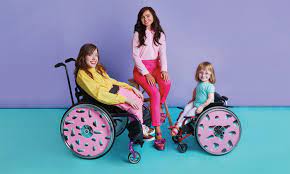Fashion brands are no strangers to what it takes to captivate an audience, but the way in which they express themselves in that effort has grown incredibly diverse over the last few years. The stigma of price and not being able to afford designer clothes have been eliminated as more high-end fashion brands make their way into mainstream markets. Many brands also offer collections at a variety of price points with t-shirts starting at 24 bucks and dresses only costing 200 or so dollars.
Introduction

Fashion is an industry that has long been inaccessible for people with disabilities. But as the world becomes more inclusive, fashion is beginning to catch up. There are now more options than ever before for people with disabilities to express their style and be fashionable.
There are a few key reasons why fashion has been slow to become more accessible. First, designers have not typically considered the needs of people with disabilities when creating their collections. Second, the fashion industry relies heavily on able-bodied models to showcase the latest trends, which can make it seem like Paralympic athletes or wheelchair users are not welcome in the world of fashion.
Fortunately, that is beginning to change. Designers are increasingly incorporating disability into their work, and there are a growing number of para-model agencies that represent people with disabilities. As awareness of the need for accessibility in fashion grows, we can only hope that the industry will continue to make progress in this area.
Ramping Up Fashion and the Disabled Community
Inclusivity is becoming more and more important in the fashion industry, and that includes making clothing and accessories accessible for people with disabilities. Some brands are already ahead of the curve when it comes to this, but there’s always room for improvement.
There are a few things that need to be taken into consideration when making fashion more accessible for the disabled community. Firstly, designers need to be aware of the different types of disabilities that their customers might have. This includes both visible and invisible disabilities. Different people have different needs, so it’s important to be as inclusive as possible.
Secondly, designers need to consider how their clothing can be worn by people with different types of disabilities. For example, some garments might need to be designed in a way that they can be easily put on or taken off by someone who has limited use of their hands. Thirdly, it’s important to consider the various types of assistive devices that people with disabilities use. For example, many blind or visually impaired people use canes or guide dogs. These devices need to be considered when designing clothing and accessories so that they can be used without difficulty.
Finally, it’s important to remember that disabled people are just like everyone else: they want to look good and feel confident in their clothes. Designers should keep this in mind when creating new collections. By being more inclusive, the fashion industry can help break down barriers and make the world a more accessible place for everyone.
Why the disability community needs fashion equality
There is a growing movement of people with disabilities who are demanding fashion equality. They want to see more people with disabilities represented in the fashion industry and they want clothes that are designed for people with disabilities.
The disability community has long been overlooked by the fashion industry. But as the world becomes more inclusive, the disability community is starting to demand its fair share of attention.
People with disabilities have unique needs when it comes to clothing. For example, many need clothes that are easier to get on and off, or that have special closures that accommodate their particular disability. Others need clothes that are made from different materials than traditional clothing, to account for sensory issues or skin sensitivities.
There are a few companies out there that are starting to design clothes specifically for people with disabilities. But there is still a long way to go to achieve fashion equality for the disability community.
The good news is that the tide is slowly turning. With increasing pressure from the disability community, it’s only a matter of time before the fashion industry starts to take notice and make real changes to become more inclusive.
Ramping Up Fashion’s Accessible Future
Fashion is an ever-evolving industry and one that is always looking for new talent. Inclusivity is a huge part of the fashion industry and one that is often overlooked. There are many people with disabilities who have a keen eye for fashion and style but lack the platform to showcase their talent.
This is where Fashion’s Accessible Future comes in. This initiative was set up to help ramp up the accessibility of fashion for those with disabilities. It does this by working with leading fashion brands, designers, and retailers to help them create more inclusive designs and products.
So far, the initiative has been a huge success with many major brands taking part. This includes high street giants like ASOS and Topshop as well as luxury labels like Burberry and Gucci. Fashion’s Accessible Future is helping to change the face of fashion and is making sure that everyone can enjoy the latest trends, regardless of their ability.
Thank You
As we work to make fashion more accessible for everyone, we wanted to take a moment to say thank you. Thank you to our customers who have made us who we are today. Thank you to our employees who dedicate themselves to making fashion more accessible. And thank you to the countless people who have supported us along the way.
We would not be where we are today without all of you. As we continue working towards our goal of making fashion accessible for everyone, we remain grateful for your support. Thank you from the bottom of our hearts.